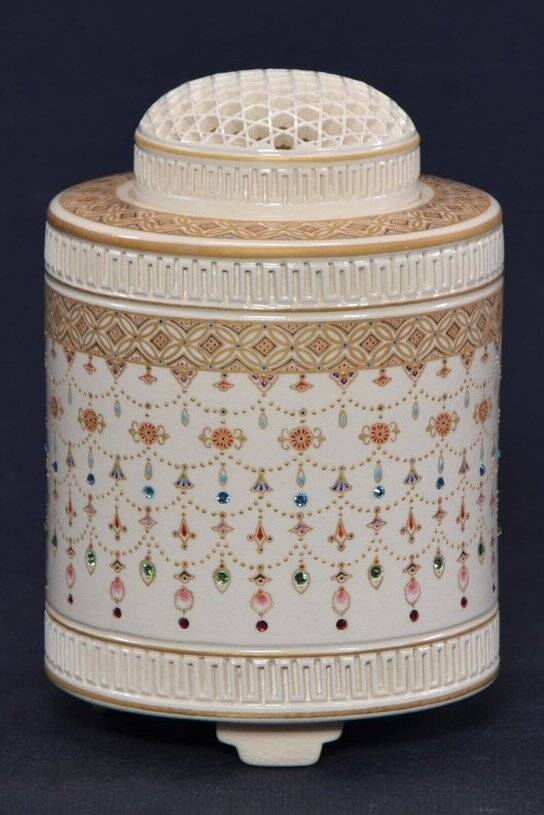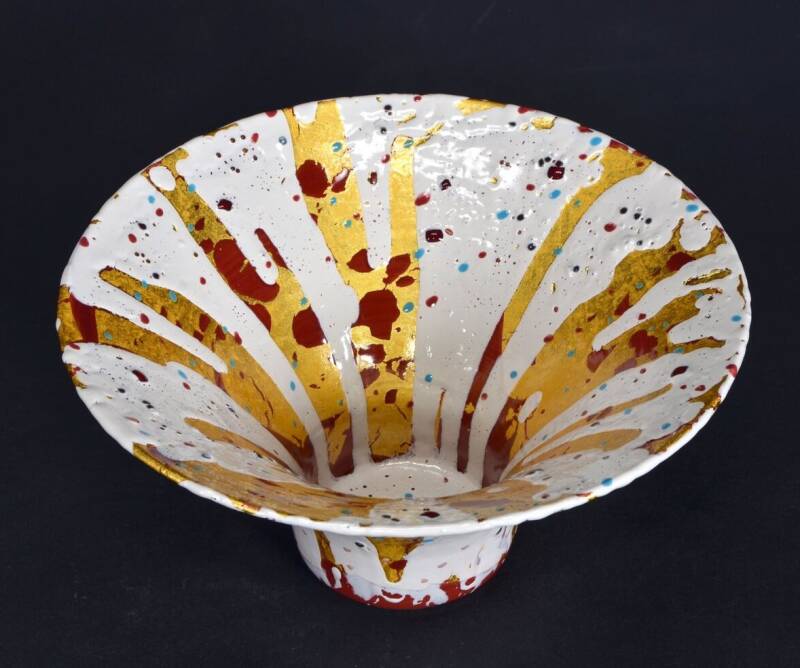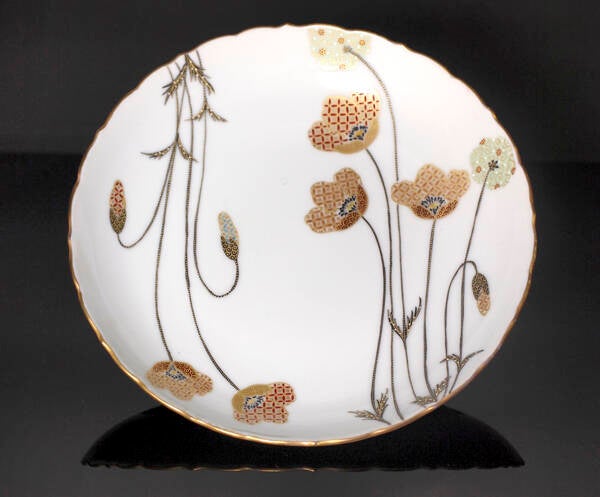Modern Satsuma: New forms in old tradition
This website focuses on Satsuma and Satsuma style pottery from a relatively short period, between about 1850 and 1930. The time when export Satsuma, as we know it, was able to flourish thanks to tremendous interest from the West. Although much of that export Satsuma, was produced en masse, and in many cases not worth collecting, this period also produced many great masters. Kinkozan, Chin Jukan, Yabu Meizan, Seikozan and Ito Tozan are just some of the most famous names. Even longer is the list of lesser-known masters like Bankozan, Ryuun Fuzan or Hankinzan, and many others who will forever remain unknown because they did not sign their work or because they signed their work with the name of the workshop for which they worked. They all worked in a long tradition of Satsuma ceramics, in which over several centuries there was searching and experimentation to produce the right, white clay. A time also of searching and experimenting to get the right glazes and expand the color palette. Eventually this led to the success Satsuma pottery had at the first world exhibitions, and an explosion in demand from the West. Potters and decorators scattered throughout Japan rushed to meet this enormous demand, Japan had a huge surplus of highly skilled craftsmen who could practice and perfect their skills in small studios or large workshops and factories. The huge demand led to segmentation of production. High-quality products, sometimes regular masterpieces were produced less and less, because they were labor-intensive and therefore costly. Satsuma products of mediocre and sometimes downright inferior quality were produced in millions and shipped to Europe and the United States. Eventually, this in turn led to declining demand, and from the Showa period onward, hardly any good Satsuma was made. The economic situation throughout the world had worsened, and high-quality products, some requiring weeks of work, were too expensive to produce. Many companies closed their doors, often after the death of an illustrious predecessor, and insufficient financial prospects for possible successors.
Nevertheless, both authentic Satsuma and Satsuma-style pottery of high quality was and still is produced today, albeit on a relatively small scale by a limited number of masters of this genre. A few kiln, as Chin Jukan, now led by the fifteenth generation, the Keida Kiln (Keida Masataro) and Ito Tozan (until 1970 ) build on the legacy of their illustrious predecessors. But fortunately there are also new names of artisans , who feel pride in the peerless craftsmanship of the delicate paintings and intricate patterns of Satsuma pottery and are both building on old tradition and searching for new forms to shape it.
To show that Satsuma pottery is still alive and moving forward, we present here four of these contemporary Satsuma masters, there are more, two of them from Kagoshima and two from Kyoto.
Akihiri Furugaki 古垣明宏
Akihiro Furugaki was born in 1974 in Kagoghjima, the birthplace of Satsuma pottery.
He studied Japanese painting, specializing in both Suibokuga (painting with ink and wax) and Kyoto-Etsuke (Kyoto-style painting on pottery). He initially opened his own pottery kiln "Kaichi Kama" in Kyoto in 2006, but later moved back to his native region where he was inspired by the sky and sea of Kagoshima. There he built an important body of work, with detailed, highly refined decorations on white Satsuma, as well as Satsuma with blue Jakatsu glaze (ao Satsuma), which is a mixture of traditional white glaze and his own blue color. Jakatsu glaze ( 蛇蠍 ) is a type of glaze decoration in which blue, yellow and black glazes merge with white overglaze, creating a kind of snakeskin pattern.
He is also one of the few artists in the world who paints in detail with Yūri-Kinsai, a decoration technique in which pieces of gold leaf or other precious metal (such as silver) are applied to ceramics according to design, then glazed and fired, and the foil fuses with the glaze. It is considered one of the most difficult ceramic techniques in terms of the treatment of the gold leaf and the method of firing.
Akihiro Furugaki's work is highly regarded for its beautiful and delicate style, and he received numerous awards for his achievements.






Shiho Murota 室田梓畝
Satsuma pottery in all its forms has a large number of collectors. A small, but not insignificant, portion focuses on collecting tsubomi (薩摩蕾Satsuma buttons), which can be small masterpieces of pottery made with all the characteristics Satsuma is known for: finely cracked and ornately painted with lots of gold. The history of these buttons goes back no further than the beginning of the Meiji period. Since the Japanese did not wear buttons, they are typical exports, and so it is doubtful that buttons were ever manufactured before the opening of Japan. The enormous popularity of Satsuma pottery from the Meiji Restoration onward also led to a large production of Satsuma buttons, intended for export and for Western tourists who wanted a nice souvenir of their visit to Japan, or as gifts for those back home. The older Satsuma buttons have ornate designs of geishas, flowers or Samurai, painted with very fine detail and lots of gold. Sometimes they are encased in a silver or gold-colored metal, but most are made of plain pottery. Some of these buttons may be marked, usually only with a Shimazu cross in a circle and more often not at all. In a small number of cases, they are also made into jewelry, in the form of brooches, bracelets or necklaces.
Production of these buttons continues; they remain fun souvenirs but have also become popular collectibles. Although mass production is the norm, there are still artists today who specialize in Satsuma buttons and dedicate themselves to creating small masterpieces. One of them, and perhaps the most important, is Shiho Murota, and her studio Satsuma Shishi.
Born in Kagoshima, Shiho Murota is a true Satsuma craftsman. She graduated in textile design, after which she worked as a decorative painter for a local Satsuma pottery kiln for ten years. In 2005 she became fascinated by the miniscule beauty of vintage and antique Satsuma buttons. Shiho then set up her own studio "Shishi Satsuma" in Tarumizu, Kagoshima, specializing in button painting. Unlike the traditional Satsuma painting method, she applies the gold outlines before adding the colors, creating compartments in which the colors are painted. She works together with very skilled potters, who are able to make openwork masterpieces even from very small objects such as a button. It makes Shiho Murota's buttons highly valued in the community of Satsuma button collectors. In 2010, she won the 'Excellence Award' & 'Judges Award' of the Japan Button Grand Pris.







Tamie Ono 小野民枝
Kyo Satsuma is characterized by delicate and sometimes very naturalistic decoration, with greater influences from Western painting style, than was the case with Kagoshima Satsuma. Kinkozan Sobei VI set the tone for this Kyo Satsuma, but the style was emulated all over the country. In Kyoto itself but also in Tokyo, Yokohama, Kobe and other places, Kyo Satsuma was produced in hundreds of workshops and decoration studios, performed by thousands of decorators and often on blanks produced from Kagoshima. Overproduction, brought about by the shift from old-fashioned craftsmanship to industrialization (necessary to reduce costs), also led to deterioration in quality and eventually its demise. The art and skill of manufacturing high-quality Kyoto Satsuma was no longer, as before, handed down from generation to generation, and was more or less lost. Tamie Ono is one of the few who has dedicated herself to reviving Kyoto Satsuma in the present era, an activity she sees as a calling. Born near Kyoto in 1955, she did not grow up in an environment familiar with ceramics. However, she became passionate about the Kyo Satsuma she sometimes saw, and was determined to continue on that path herself. After high school, she attended Kyoto Prefectural Ceramics Advanced Technology where she graduated as a professional potter and ceramic painter in 1978. She then worked as a painter at Shimizu Ware Kiln in Kyoto and became a painting instructor at Kyoto Traditional Craft University in 1996, while continuing her own studies in Akae Fine Drawing" and "Kyoto Satsuma." In 2001, she established her studio "cu-nyo" and developed a style in a sophisticated color palette, with meticulously detailed designs and fabulous brushwork that she called Hana Satsuma, "gorgeous Satsuma." She had many exhibitions, and in 2012 she was appointed painting instructor at Kyoto University of Arts and Crafts. Although Tamie Ono remains faithful to Kyo-Satsuma's techniques, she also shows new developments, with her own designs and ideas without sticking to Kyo-Satsuma's long-standing copy pattern.









Hirota Saneyuki 廣田実雪
Saneyuki Hirota was born in 1947 in Fukuoka Prefecture, where he opened his own kiln in 1980. For more than 40 years he has devoted himself to creating authentic Satsuma, where the ivory-white body is covered with delicate glaze cracks and over-glaze color decoration. His work relies on the technology of Shiro Satsuma in basically the same way it has been done for centuries, however without copying it. Although his work closely related is to the Kinrande Satsuma of the Meiji period, it is undeniably modern and appropriate to the present time. According to Saneyuki Hirota, an artist must extensively cultivate the past and learn from it. His work must fit into the timeline between past and future, and people in the future will accept the works of the present time as a legacy and continue to evolve. Although he studied painting as a child and learned the pattern technique of "Yuzen painting" in Kyoto, he still finds inspiration in temples, shrines and even Noh costumes.
Saneyuki Hirota is considered a leading figure in creating contemporary Kinrande Satsuma, with designs, which through unconventional gold accents are very rich in decorative beauty and always make a noble and distinguished impression on the viewer. His works are included in the collections of the British Museum and the Kyushu National Museum.





Keizan gama 渓山窯
Keizan-gama, based in Taniyama, Kagoshima City is one of the better producers of modern but authentic Satsuma wares. It was founded in 1974 by the first Keizan, and the company currently presents itself as a three-generation family business led by the second generation Keizan, Satoshi Uchiyama. It takes pride in not producing their products through a "manufacturing line"-which involves several artisans specializing in different stages of production-but doing the forming, baking and painting all by themselves. This is at least different from what is done in most, larger kilns, and the quality of Keizan-gama Satsuma products is therefore high. It produces products that are not revolutionary in form and design, but are unmatched within that tradition because of the meticulous painting and craftsmanship with which openwork-Satsuma is made. (Incidentally, there are more ceramic companies called Keizan-gama, including in Arita, it is a common name. The difference, of course, is obvious)









Maak jouw eigen website met JouwWeb